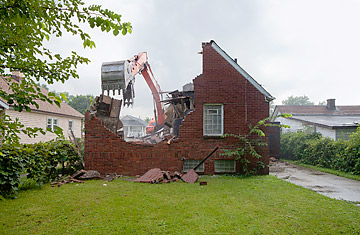
A home being destroyed in the Lee-Miles area of Cleveland
(2 of 5)
The problem is that three years on from the crisis, housing is getting worse, not better. New numbers show home sales falling, and the number of Americans behind on their mortgages is once again rising after modest improvement. While Washington has been focused on the federal debt, the U.S.'s $9.12 trillion of consumer real estate debt — down 10% from its 2008 record but still about triple what it was in 1999 — has been the real drag on recovery. According to private-sector and government economists, national home prices have plummeted 40% from their highs five years ago, the largest drop ever, worse even than during the Great Depression, wiping out $7.1 trillion of housing wealth (still most Americans' largest asset). That has left 14.6 million homeowners in the U.S. with mortgage debt greater than what their house is worth, according to Zandi. Deeply underwater homeowners, government and private economists say, hamper the economy in several key ways. For starters, they can't walk away from their homes to find jobs somewhere else, which is one reason the unemployment rate remains as high as it is. More broadly, underwater borrowers spend a disproportionate amount of their income servicing their debt every month, leaving less money to pump into local businesses; and even when they have extra cash, they are disinclined to spend it because they worry about their budget and future economic uncertainty. When they are forced to walk away and foreclose, often because of losing a job and with it the ability to pay the mortgage, it dumps more cheap supply onto the housing market, further constraining prices. Home prices have dropped 4.4% in the past 12 months. Since the beginning of 2007, homeowners have lost 5.2 million houses to foreclosure or in distressed sales, according to Moody's Analytics. Some economists predict that as many as 5 million homeowners still struggling to make payments will move into foreclosure before the crisis ends.
The hollowing out of the housing industry has put over 1 million people in the building and related trades (including construction, real estate sales, assessment and DIY retail) directly out of work; the indirect job-loss effect may triple that. But it's also responsible for a larger chunk of economic malaise, says economist Dean Baker. He figures that for every dollar drop in their houses' value, homeowners spend 6¢ less on other stuff, resulting in a collective $430 billion drop in consumer spending from the bubble's 2008 peak, or a 3% hit to the economy. Taken all together, that could be the difference between a recovery and a double-dip recession.
Economists are only now beginning to appreciate just how different this housing-driven recession is from previous downturns. "We've never had so many people underwater since the Great Depression," says Yale economist John Geanakoplos. Then as now, solving the problem required radical action. In 1933, Franklin D. Roosevelt halted the foreclosure tide by inventing things like the 30-year fixed mortgage and creating the Home Owners' Loan Corporation, which issued long-term government-backed loans to 4 million Americans facing default. Before it was all over, the government had bailed out a full 20% of the country's mortgages.
